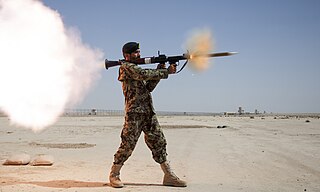
A missile is an airborne ranged weapon capable of self-propelled flight aided usually by a propellant, jet engine or rocket motor.

A weapon, arm, or armament is any implement or device that is used to deter, threaten, inflict physical damage, harm, or kill. Weapons are used to increase the efficacy and efficiency of activities such as hunting, crime, law enforcement, self-defense, warfare, or suicide. In a broader context, weapons may be construed to include anything used to gain a tactical, strategic, material, or mental advantage over an adversary or enemy target.
Penetration may refer to:
Accelerator may refer to:

A projectile is an object that is propelled by the application of an external force and then moves freely under the influence of gravity and air resistance. Although any objects in motion through space are projectiles, they are commonly found in warfare and sports.

Nuclear artillery is a subset of limited-yield tactical nuclear weapons, in particular those weapons that are launched from the ground at battlefield targets. Nuclear artillery is commonly associated with shells delivered by a cannon, but in a technical sense short-range artillery rockets or tactical ballistic missiles are also included.

Ballistics is the field of mechanics concerned with the launching, flight behaviour and impact effects of projectiles, especially ranged weapon munitions such as bullets, unguided bombs, rockets or the like; the science or art of designing and accelerating projectiles so as to achieve a desired performance.

Aerial warfare is the use of military aircraft and other flying machines in warfare. Aerial warfare includes bombers attacking enemy installations or a concentration of enemy troops or strategic targets; fighter aircraft battling for control of airspace; attack aircraft engaging in close air support against ground targets; naval aviation flying against sea and nearby land targets; gliders, helicopters and other aircraft to carry airborne forces such as paratroopers; aerial refueling tankers to extend operation time or range; and military transport aircraft to move cargo and personnel.

Shoulder-fired missile, shoulder-launched missile or man-portable missile, among other variants, are common slang-terms to describe high-caliber shoulder-mounted weapons systems – that is: weapons firing large heavy projectiles ("missiles"), typically using the backblast principle, which are small enough to be carried by a single person and fired while held on one's shoulder. The word "missile" in this context is used in its original broad sense of a heavy projectile, and encompasses all shells and rockets, guided or unguided. A more formal variant is simply shoulder-fired weapons system and the like.
In shooter games, rocket jumping is the technique of using the knockback of an explosive weapon, most often a rocket launcher, to launch the shooter into the air. The aim of this technique is to reach heights, distances and speed that standard character movement cannot achieve. Although the origin of rocket jumping is unclear, its usage was popularized by Quake.

A ranged weapon is any weapon that can engage targets beyond hand-to-hand distance, i.e. at distances greater than the physical reach of the user holding the weapon itself. The act of using such a weapon is also known as shooting. It is sometimes also called projectile weapon or missile weapon because it typically works by launching solid projectiles ("missiles"), though technically a fluid-projector and a directed-energy weapon are also ranged weapons. In contrast, a weapon intended to be used in hand-to-hand combat is called a melee weapon.
A rocket is a vehicle, missile, or aircraft propelled by an engine that creates thrust from a high speed exhaust jet made exclusively from propellant.
A gun is an object that propels a projectile through a hollow tube, primarily as weaponry.
A kinetic bombardment or a kinetic orbital strike is the hypothetical act of attacking a planetary surface with an inert kinetic projectile from orbit, where the destructive power comes from the kinetic energy of the projectile impacting at very high speeds. The concept originated during the Cold War.

A kinetic energy weapon is a projectile weapon based solely on a projectile's kinetic energy to inflict damage to a target, instead of using any explosive, incendiary/thermal, chemical or radiological payload. All kinetic weapons work by attaining a high flight speed — generally supersonic or even up to hypervelocity — and collide with their targets, converting its kinetic energy and relative impulse into destructive shock waves, heat and cavitation. In kinetic weapons with unpowered flight, the muzzle velocity or launch velocity often determines the effective range and potential damage of the kinetic projectile.

A precision-guided munition (PGM), also called a smart weapon, smart munition, or smart bomb, is a guided munition intended to hit a specific target, to minimize collateral damage and increase lethality against intended targets. During the Persian Gulf War guided munitions accounted for only 9% of weapons fired, but accounted for 75% of all successful hits. Despite guided weapons generally being used on more difficult targets, they were still 35 times more likely to destroy their targets per weapon dropped.

Man-portable anti-tank systems are traditionally portable shoulder-launched projectile systems firing heavy shell-type projectiles, typically designed to combat protected targets, such as armoured vehicles, field fortifications and at times even low-flying aircraft.
An arrow is a projectile launched from a bow.










